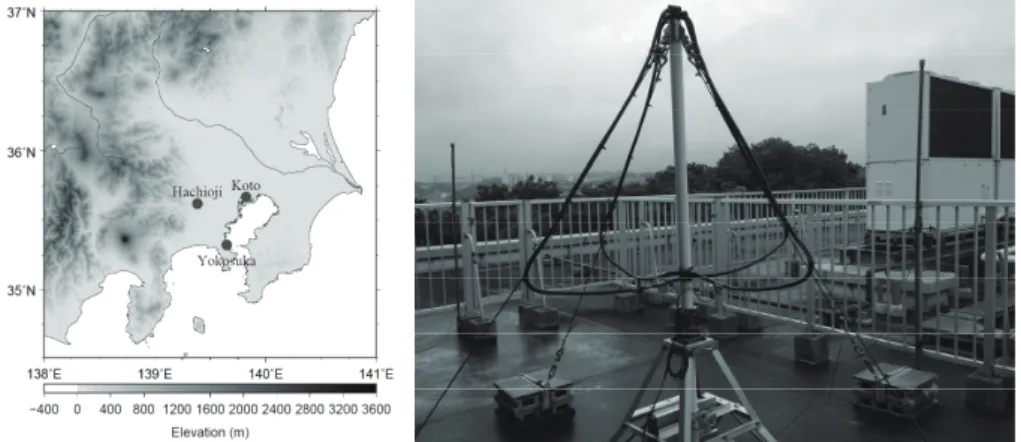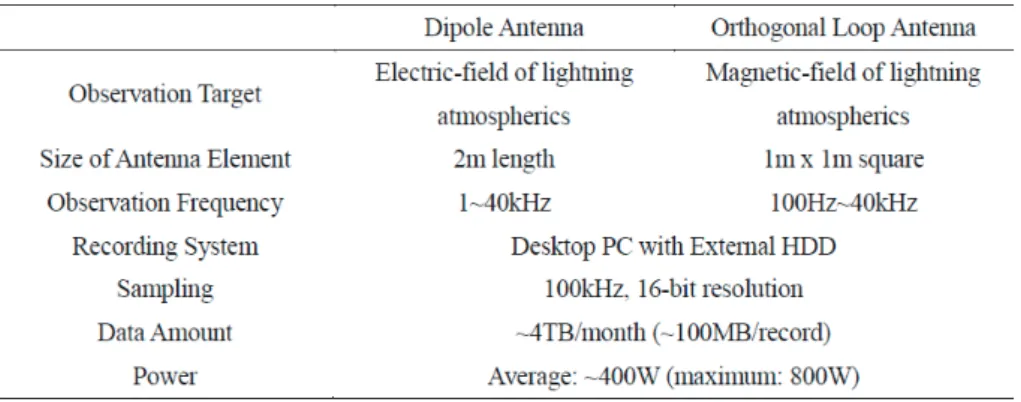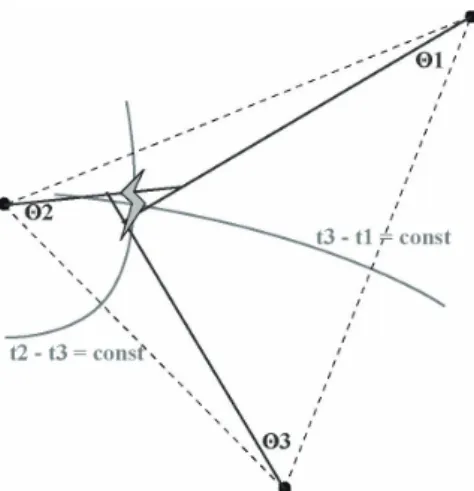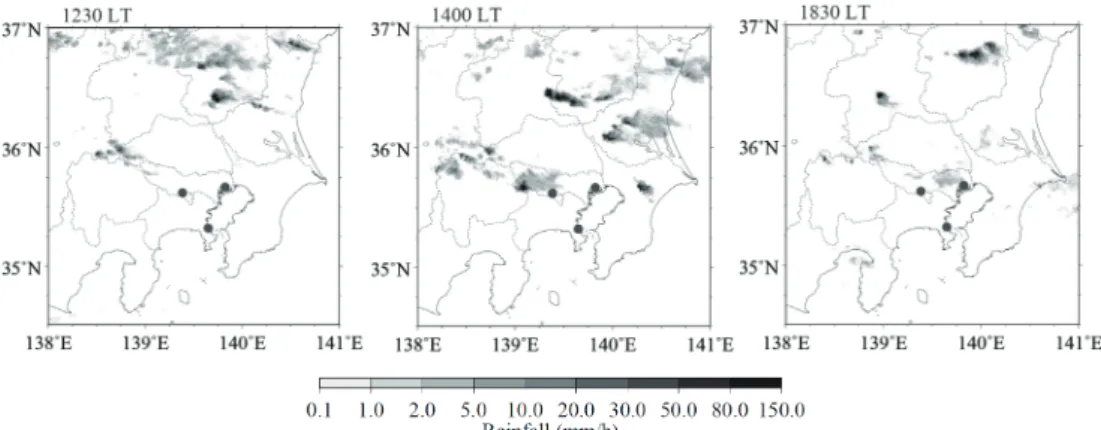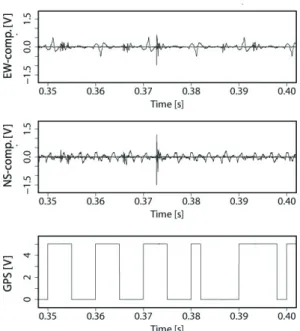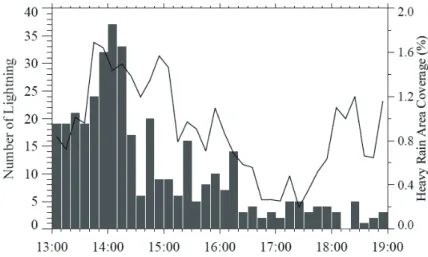GEOGRAPHICAL REPORTS
OF TOKYO METROPOLITAN UNIVERSITY 49 (2014) 13–22
OVERVIEW OF LIGHTNING OBSERVATION NETWORK WITH ELF−VLF ELECTROMAGNETIC MEASUREMENTS
OVER TOKYO METROPOLITAN AREA
HAMADA Jun-Ichi, Kozo YAMASHITA*, Yukihiro TAKAHASHI**, Shunsuke KANAMORI, Hitoshi YOKOYAMA***, and Jun MATSUMOTO
Abstract An Extremely Low Frequency−Very Low Frequency (ELF−VLF) radio wave observation network system in the Tokyo metropolitan area has been newly established to detect lightning activity and investigate the characteristics of heavy rainfall induced by thunderstorms.
The VLF electromagnetic waveforms induced by lightning (commonly known as “sferics”) were observed at three sites (Hachioji, Yokosuka, and Koto) from the Baiu season until mid-summer 2013. The observed VLF sferics were used to detect lightning frequency and estimating the geo-locate the lightning source according to the time of arrival (TOA) method. The preliminary results suggest that this system could detect the lightning signals from convective cloud systems, despites differences in detection sensitivity and diurnal cycles between sites. Further studies are required to optimize the observation network system and refine the VLF sferics analysis method to enable the collection of high-accuracy lightning data.
Key words: lightning, Extremely Low Frequency−Very Low Frequency radio observation, Tokyo metropolitan area, heavy rainfall
1. Introduction
Localized heavy rainfall developed in association with thunderstorms has been known to induce natural disasters such as flooding and landslides throughout Japan. In recent years, the frequency of such events has tended to increase (Fujibe et al., 2006; JMA, 2013), and the increased occurrence of torrential rainfall has caused extensive damage to large urban centers such as the Tokyo metropolitan area (Kato and Maki, 2009). Thus, the development of a system that can monitor and predict such extreme weathers in the Tokyo metropolitan district is required urgently to mitigate the damage caused by future events (Maki et al., 2011).
Recently, lightning observation has become the focus of considerable attention. Lightning
* Department of Electrical Engineering, Salesian Polytechnic
** Department of Cosmosciences, Graduate School of Science, Hokkaido University
*** Tokyo Metropolitan Research Institute for Environmental Protection
- 12 - - 13 -
observation data are used not only for the investigation of lightning damage, but also as a proxy for convection activity (i.e., vertical wind). In a previous case study, lightning observations from the National Lightning Detection Network (NLDN) in the USA were assimilated into a meso-scale model designed to improve the forecasting of the initial conditions of heavy rainfall (Mansell et al.
2007). The Japan Meteorological Agency has also established a nationwide Lightning Detection Network system (LIDEN) using Very High Frequency/Low Frequency (VHF/LF) radio wave to nowcast intra-cloud (IC) and cloud-to-ground (CG) lightning activity (Kasahara, 2011). Inoue and Inoue (2007) described the characteristics of the GPS-derived water vapor field in relation to thunderstorms on summer days over the Kanto district, whereas Ogrua et al. (2002) examined the spatiotemporal distribution of lightning activity and its triggering mechanisms over the Kanto district in mid-summer. However, lightning activity and its generation mechanisms for the Tokyo metropolitan area have yet to be fully understood, particularly in relation to torrential rainfall generation.
To address this, we initiated a research project at Tokyo Metropolitan University entitled
“Predictability of urban torrential rainfall using thunder activities”. This project aims to improve understanding of the processes and mechanisms underlying torrential rainfall over the Tokyo metropolitan area through the development of a lightning observation network and the use of numerical simulations. An ELF−VLF radio wave observation system has been installed and operated as part of this study. One of the most advanced ground-based VLF observation networks, the World Wide Lightning Location Network (WWLLN, see http://wwlln.net), provides a basis for global lightning climatology that resolves both diurnal and seasonal variations (Virts et al., 2013).
The WWLLN and satellite optical lightning observations (Christian et al., 2003) are the only existing lightning dataset that provide global coverage. For the WWLLN, the detection efficiency of CG activity over the USA is about 10% of that of the NLDN, suggesting that this network offers strong potential for meteorological applications (Abarca et al., 2010). The VLF observation system offers additional advantages: it can detect the occurrence and scale of individual lightning discharges and enables quantitative evaluation of the intensity of atmospheric convection.
Moreover, the VLF observation system offers considerable flexibility in terms of observational setting and has relatively low installation and running costs. The VLF observation system adopted in the present study was originally developed by a research group from Hokkaido, Tohoku, and Chiba universities and has operated over a wide area in Southeast Asia. However, one of the current challenges facing this technology is the optimization of the VLF observation network for the detection of lightning and estimation of its location and energy over local areas.
Here, we provide a brief introduction to the lightning observation network established in the area, clarify the status of radio wave observation, and describe the preliminary observational results.
- 14 -
Fig. 1 Observational sites of ELF−VLF electromagnetic measurements in the Tokyo metropolitan area
(left) and a photo of the system installed at Tokyo Metropolitan University, Hachioji (right). A set of orthogonal loop antennas was used for magnetic field measurements. A dipole antenna and a
GPS antenna were installed for electric field measurements, and observational time synchronization, respectively.
2. Lightning observation network over Tokyo metropolitan area
Ground-based electromagnetic measurements for lightning detection
The ELF−VLF radio observation system was installed at three sites in the Tokyo metropolitan area after checking local environmental conditions (e.g., noise level, infrastructure, accessibility).
The installation sites were located at Tokyo Metropolitan University (TMU) at Hachioji (35.620°N, 139.384°E), the Japan Agency for Marine-Earth Science (JAMSTEC) at Yokosuka (35.321°N, 139.650°E), and the Tokyo Metropolitan Research Institute for Environmental Protection (TMRI) at Koto (35.668°N, 139.824°E) (Fig. 1).
Lightning discharge radiates a broad spectrum of electromagnetic waves, ranging from several Hz to many tens of MHz, such electromagnetic waves are commonly referred to as sferics. The distance over which these waves travel depends on their frequency. For example, the radio waves in the VLF range (3−30 kHz) can be propagated in the Earth’s waveguide between the ground and lower ionosphere about 2,000 km away from the source of the lightning. By measuring sferics in the VLF range at several observation sites, it is possible to monitor lightning activity (i.e., both position and electrical scale for each event) occurring throughout Japan. The measurement of VLF radio waves in this manner allows detection of the vertical component of lightning, also known as CG lightning. In addition to the long-distance signals, direct signals from the IC/CG discharge near the observation site can be detected by our network in the Tokyo metropolitan area.
- 14 - - 15 -
Fig. 1 Observational sites of ELF−VLF electromagnetic measurements in the Tokyo metropolitan area
(left) and a photo of the system installed at Tokyo Metropolitan University, Hachioji (right). A set of orthogonal loop antennas was used for magnetic field measurements. A dipole antenna and a
GPS antenna were installed for electric field measurements, and observational time synchronization, respectively.
2. Lightning observation network over Tokyo metropolitan area
Ground-based electromagnetic measurements for lightning detection
The ELF−VLF radio observation system was installed at three sites in the Tokyo metropolitan area after checking local environmental conditions (e.g., noise level, infrastructure, accessibility).
The installation sites were located at Tokyo Metropolitan University (TMU) at Hachioji (35.620°N, 139.384°E), the Japan Agency for Marine-Earth Science (JAMSTEC) at Yokosuka (35.321°N, 139.650°E), and the Tokyo Metropolitan Research Institute for Environmental Protection (TMRI) at Koto (35.668°N, 139.824°E) (Fig. 1).
Lightning discharge radiates a broad spectrum of electromagnetic waves, ranging from several Hz to many tens of MHz, such electromagnetic waves are commonly referred to as sferics. The distance over which these waves travel depends on their frequency. For example, the radio waves in the VLF range (3−30 kHz) can be propagated in the Earth’s waveguide between the ground and lower ionosphere about 2,000 km away from the source of the lightning. By measuring sferics in the VLF range at several observation sites, it is possible to monitor lightning activity (i.e., both position and electrical scale for each event) occurring throughout Japan. The measurement of VLF radio waves in this manner allows detection of the vertical component of lightning, also known as CG lightning. In addition to the long-distance signals, direct signals from the IC/CG discharge near the observation site can be detected by our network in the Tokyo metropolitan area.
Fig. 1 Observational sites of ELF−VLF electromagnetic measurements in the Tokyo metropolitan area
(left) and a photo of the system installed at Tokyo Metropolitan University, Hachioji (right). A set of orthogonal loop antennas was used for magnetic field measurements. A dipole antenna and a
GPS antenna were installed for electric field measurements, and observational time synchronization, respectively.
2. Lightning observation network over Tokyo metropolitan area
Ground-based electromagnetic measurements for lightning detection
The ELF−VLF radio observation system was installed at three sites in the Tokyo metropolitan area after checking local environmental conditions (e.g., noise level, infrastructure, accessibility).
The installation sites were located at Tokyo Metropolitan University (TMU) at Hachioji (35.620°N, 139.384°E), the Japan Agency for Marine-Earth Science (JAMSTEC) at Yokosuka (35.321°N, 139.650°E), and the Tokyo Metropolitan Research Institute for Environmental Protection (TMRI) at Koto (35.668°N, 139.824°E) (Fig. 1).
Lightning discharge radiates a broad spectrum of electromagnetic waves, ranging from several Hz to many tens of MHz, such electromagnetic waves are commonly referred to as sferics. The distance over which these waves travel depends on their frequency. For example, the radio waves in the VLF range (3−30 kHz) can be propagated in the Earth’s waveguide between the ground and lower ionosphere about 2,000 km away from the source of the lightning. By measuring sferics in the VLF range at several observation sites, it is possible to monitor lightning activity (i.e., both position and electrical scale for each event) occurring throughout Japan. The measurement of VLF radio waves in this manner allows detection of the vertical component of lightning, also known as CG lightning. In addition to the long-distance signals, direct signals from the IC/CG discharge near the observation site can be detected by our network in the Tokyo metropolitan area.
Fig. 1 Observational sites of ELF−VLF electromagnetic measurements in the Tokyo metropolitan area
(left) and a photo of the system installed at Tokyo Metropolitan University, Hachioji (right). A set of orthogonal loop antennas was used for magnetic field measurements. A dipole antenna and a
GPS antenna were installed for electric field measurements, and observational time synchronization, respectively.
2. Lightning observation network over Tokyo metropolitan area
Ground-based electromagnetic measurements for lightning detection
The ELF−VLF radio observation system was installed at three sites in the Tokyo metropolitan area after checking local environmental conditions (e.g., noise level, infrastructure, accessibility).
The installation sites were located at Tokyo Metropolitan University (TMU) at Hachioji (35.620°N, 139.384°E), the Japan Agency for Marine-Earth Science (JAMSTEC) at Yokosuka (35.321°N, 139.650°E), and the Tokyo Metropolitan Research Institute for Environmental Protection (TMRI) at Koto (35.668°N, 139.824°E) (Fig. 1).
Lightning discharge radiates a broad spectrum of electromagnetic waves, ranging from several Hz to many tens of MHz, such electromagnetic waves are commonly referred to as sferics. The distance over which these waves travel depends on their frequency. For example, the radio waves in the VLF range (3−30 kHz) can be propagated in the Earth’s waveguide between the ground and lower ionosphere about 2,000 km away from the source of the lightning. By measuring sferics in the VLF range at several observation sites, it is possible to monitor lightning activity (i.e., both position and electrical scale for each event) occurring throughout Japan. The measurement of VLF radio waves in this manner allows detection of the vertical component of lightning, also known as CG lightning. In addition to the long-distance signals, direct signals from the IC/CG discharge near the observation site can be detected by our network in the Tokyo metropolitan area.
Fig. 1 Observational sites of ELF−VLF electromagnetic measurements in the Tokyo metropolitan area
(left) and a photo of the system installed at Tokyo Metropolitan University, Hachioji (right). A set of orthogonal loop antennas was used for magnetic field measurements. A dipole antenna and a
GPS antenna were installed for electric field measurements, and observational time synchronization, respectively.
2. Lightning observation network over Tokyo metropolitan area
Ground-based electromagnetic measurements for lightning detection
The ELF−VLF radio observation system was installed at three sites in the Tokyo metropolitan area after checking local environmental conditions (e.g., noise level, infrastructure, accessibility).
The installation sites were located at Tokyo Metropolitan University (TMU) at Hachioji (35.620°N, 139.384°E), the Japan Agency for Marine-Earth Science (JAMSTEC) at Yokosuka (35.321°N, 139.650°E), and the Tokyo Metropolitan Research Institute for Environmental Protection (TMRI) at Koto (35.668°N, 139.824°E) (Fig. 1).
Lightning discharge radiates a broad spectrum of electromagnetic waves, ranging from several Hz to many tens of MHz, such electromagnetic waves are commonly referred to as sferics. The distance over which these waves travel depends on their frequency. For example, the radio waves in the VLF range (3−30 kHz) can be propagated in the Earth’s waveguide between the ground and lower ionosphere about 2,000 km away from the source of the lightning. By measuring sferics in the VLF range at several observation sites, it is possible to monitor lightning activity (i.e., both position and electrical scale for each event) occurring throughout Japan. The measurement of VLF radio waves in this manner allows detection of the vertical component of lightning, also known as CG lightning. In addition to the long-distance signals, direct signals from the IC/CG discharge near the observation site can be detected by our network in the Tokyo metropolitan area.
Fig. 1 Observational sites of ELF−VLF electromagnetic measurements in the Tokyo metropolitan area
(left) and a photo of the system installed at Tokyo Metropolitan University, Hachioji (right). A set of orthogonal loop antennas was used for magnetic field measurements. A dipole antenna and a
GPS antenna were installed for electric field measurements, and observational time synchronization, respectively.
2. Lightning observation network over Tokyo metropolitan area
Ground-based electromagnetic measurements for lightning detection
The ELF−VLF radio observation system was installed at three sites in the Tokyo metropolitan area after checking local environmental conditions (e.g., noise level, infrastructure, accessibility).
The installation sites were located at Tokyo Metropolitan University (TMU) at Hachioji (35.620°N, 139.384°E), the Japan Agency for Marine-Earth Science (JAMSTEC) at Yokosuka (35.321°N, 139.650°E), and the Tokyo Metropolitan Research Institute for Environmental Protection (TMRI) at Koto (35.668°N, 139.824°E) (Fig. 1).
Lightning discharge radiates a broad spectrum of electromagnetic waves, ranging from several Hz to many tens of MHz, such electromagnetic waves are commonly referred to as sferics. The distance over which these waves travel depends on their frequency. For example, the radio waves in the VLF range (3−30 kHz) can be propagated in the Earth’s waveguide between the ground and lower ionosphere about 2,000 km away from the source of the lightning. By measuring sferics in the VLF range at several observation sites, it is possible to monitor lightning activity (i.e., both position and electrical scale for each event) occurring throughout Japan. The measurement of VLF radio waves in this manner allows detection of the vertical component of lightning, also known as CG lightning. In addition to the long-distance signals, direct signals from the IC/CG discharge near the observation site can be detected by our network in the Tokyo metropolitan area.
Table 1 Specifications of ELF−VLF radio observation system
System specification for ELF−VLF radio observation system
The specification of our ELF−VLF radio observation system is summarized in Table 1. A set of orthogonal loop antennas is used to measure the magnetic field (both north-south and east-west components) of VLF sferics induced by lightning discharges. A dipole antenna is used to measure the vertical electric field component of the sferics. The output signals from antennas are amplified by a pre amplifier and main amplifier and are subsequently recorded by a personal computer (PC) together with GPS IRIG-B time code signals. The PC is used to monitor lightning and records both the electric and magnetic field components of the waveforms of sferics. The PC is not connected to the Internet at all sites and is contained within a box placed outdoors at Hachioji and Yokosuka sites.
In the current system configuration, the sampling frequency of the analog/digital (A/D) converter is 100 kHz and the recording duration is 30 seconds in each minute, although this can be adjusted depending on the observation target. Because the temporal resolution is sufficiently high, the obtained data enables us to derive the occurrence location and timing of source lightning with accuracies of 10 km and 10 µs, respectively. Furthermore, because the system covers a broad frequency range of 1−40 kHz, it is possible to derive the current moment change of lightning.
Methodology for estimating lightning location
Based on the arrival time detected for the VLF sferics, the time-of-arrival (TOA) method was used to detect lightning location as described in Fig. 2. In the TOA method, differences in the arrival time of lightning atmospherics at three sites are typically used to determine the location of parent lightning (e.g., Dowden et al., 2002; Yamashita et al., 2011). Each solid line in Fig. 2 is a hyperbola along which the difference in radio arrival times observed between the two sites is constant. Thus, the intersection of the two solid lines corresponds to the parent lightning location.
The methodology was described in more detail by Yamashita et al., (2011).
- 16 -
Fig. 2 Schematic representation of the use of the time of arrival method (TOA) to estimate the location of
lightning occurrence using the VLF observation network.
3. Preliminary observational results
Operational status
Simultaneous observation at the three sites was undertaken from mid-May to early October, 2013 (i.e., an observation period of about 6 months). Because the amount of data collected (4 TB per month for each station) was too large to allow continuous storage, we replaced the storage hard disk drive (HDD) at least every two weeks. Though the data missing periods at even one station were existed totally for about 1−2 months, magnetic field data observed with a set of orthogonal loop antennas were collected for all sites for the Baiu and mid-summer seasons. Conversely, no electric field data (observed with a dipole antenna) could be obtained throughout the study period, except at the Koto site, owing to the high noise level.
Thus, any gaps in data can be attributed primarily to issues associated with recording data by PC or to instability in GPS signals; this highlights the need to ensure high-accuracy time synchronization between sites. To improve the continuity of observations, it will be essential to improve the thermal environment of the PC storage space and to incorporate a continuous internet connection to allow monitoring of observational conditions. In addition, the volume of data must be reduced to allow remote site operation; this may be achieved by incorporating a trigger recording mode, such that the system will only record for a fixed period of time after a certain trigger threshold is exceeded (i.e., will only record lightning signals, not background data).
- 16 - - 17 -
Fig. 3 Rainfall distribution over the Kanto district obtained from the Japan Meteorological Agency (JMA) radar rainfall analysis at 12:30 (left), 14:00 (center), and 18:30 (right) at local time (LT) on June 22, 2013. Shading indicates rainfall intensity (mm/hour). The ELF−VLF observation sites are denoted
by closed circles.
Sensitivity of lightning detection
As a case study, we used data from June 22, 2013, to confirm the performance of our system in terms of lightning detection. Because the Baiu front (typically located over southern Japan) and the associated pressure trough passed over the Kanto district, heavy rainfall and active lightning were induced over a wide area that included the Tokyo metropolitan area. A convective cloud system developed in the early afternoon near the mountainous region and had moved to the plain region by the evening (Fig. 3).
Lightning events are detected from the VLF sferics by a set of orthogonal loop antennas. An example of a lightning event detected at TMU (i.e., Hachioji) on June 22, 2013, is presented in Fig.
4. A high-pass filter was applied to the raw waveform data (thin line) to eliminate geomagnetic noise (i.e., by taking the deviation between adjoining samples of the raw data). The local maximum over the threshold value (0.25 volts) in the filtered waveforms (thick line) was defined as the peak timing of VLF sferics, and this peak was recorded as the arrival time of the direct wave radiated from lightning. In this case, the lightning event was observed to occur for 0.01 s, between 13:56:08.37 and 13:56:08.38.
The detection sensitivity of the lightning signal at the three observational sites is illustrated in Fig. 5. The Hachioji and Koto sites exhibited relatively high detection sensitivity (235 and 358 times/hour, respectively, on average), whereas low sensitivity was found at the Yokosuka site (69 times/hour, on average). Overall, the daily frequency of lightning detection was 1,656, 5,640, and 8,592 times per day for the Yokosuka, Hachioji, and Koto sites, respectively. The detection sensitivities at all sites exhibit a clear diurnal cycle, with an afternoon maximum at around 15:00 LT. Additionally, a midnight peak (around 00:00 LT) was observed at the Hachioji and high detection sensitivities were recognized in the morning (08:00−12:00 LT) at the Koto site.
- 18 -
Fig. 4 An example of a lightning-induced waveform observed at Tokyo Metropolitan University (Hachioji site) during 13:56:08−13:56:09 June 22, 2013. The magnetic field components of the waveform are shown in the top (east-west component) and middle (north-south component) panels and the GPS IRIG-B time code signal is shown in the bottom panel (units: volts).
Fig. 5 Frequency of the lightning detection signal (number/hour) at the Hachioji (solid line), Yokosuka
(dotted line), and Koto (dashed line) sites on June 22, 2003.
These temporal and spatial differences in detection sensitivity can be attributed partly to the distance between the lightning locations and observational sites. In this context, the high sensitivity observed at the Koto and Hachioji sites could be result of the closer proximity of developed convective system to these sites than to Yokosuka (Fig. 3), such that IC lightning signals associated with convection could contribute to the frequency of lightning detection. Kasahara (2011) described
- 18 - - 19 -
the average seasonal variation of IC and CG lightning over Japan using a LIDEN dataset spanning 5 years and determined that around 3,000−4,000 CG and 7,000−8,000 IC lightning events (times/day, on average) were observed in June. Thus, the results we obtained regarding daily lightning frequency can be explained by the sum of CG and IC lightning signals. However, further studies will be required to improve understanding of the causes of differences in detection sensitivity between sites. This could be achieved by analyzing different weather conditions and investigating the factors controlling threshold value used to detect the lightning signal.
Finally, temporal variations in lightning frequency (estimated according to the TOA method) and the areal coverage of heavy rainfall (i.e., rainfall intensity greater than or equal to 50 mm/hour) over the Kanto district are illustrated in Fig. 6. The maximum lightning frequency was 38 times/10 minutes during 14:00−14:10. Moreover, the peaks in lightning frequency and heavy rainfall coverage correspond closely (around 14:00 LT), although an evening peak (around 18:30 LT, when the convective area was located over the northeastern Kanto district, i.e., relatively far from the study sites) was detected only for the rainfall. Thus, our results suggest that the system has the ability to detect lightning signals from convective cloud systems over certain distances.
Fig. 6 Temporal variation in lightning frequency (bars) and areal coverage of heavy rainfall pixels (i.e., rainfall greater than or equal to 50 mm/hour, solid line) during 13:00−19:00 on June 22, 2013. The areal coverage of the heavy rainfall was obtained from the JMA radar rainfall analysis at a 1km x 1 km grid size for the Kanto district.
4. Conclusions and further study
We have newly established an ELF−VLF radio wave observation network system in the Tokyo metropolitan area to detect lightning activity and investigate the characteristics of heavy rainfall induced by thunderstorms. The VLF electromagnetic waveforms (known as sferics) were
- 20 -
observed at three sites (Hachioji, Yokosuka, and Koto) in the Baiu and mid-summer seasons (i.e., from mid-May to early October, 2013), although there were periods of missing (totally 1−2 months) due to operational issues with the PC and GPS receiver. The observed VLF sferics were used to detect lightning activity and estimate lightning locations according to the TOA method.
Based on our preliminary observational results, we described temporal and spatial variations in detection sensitivity for lightning signals on June 22, 2013. The obtained results suggest that our system offers potential for the detection of lightning signals from convective cloud systems, despite differences in detection sensitivity and diurnal cycles between sites. In future, the ELF−VLF radio wave observation system and VLF waveform analysis processes should be optimized to allow the collection of high-accuracy lightning data.
Acknowledgements
This work is supported by the research grants for Project Research, Tokyo Metropolitan University, “Predictability of urban torrential rainfall using thunder activity”, Principal Investigator (PI) : Prof. Jun Matsumoto and for Mission Research on Sustainable Humanosphere from Research Institute for Sustainable Humanosphere (RISH), Kyoto University, “Integrated observational study for thunder storm over the Tokyo metropolitan area”, PI: Prof. Jun Matsumoto.
References
Abarca, S. F., Corbosiero, K. L., and Galarneau Jr., T. J. 2010. An evaluation of the Worldwide Lightning Location Network (WWLLN) using the National Lightning Detection Network (NLDN) as ground truth. Journal of Geophysical Research 115: D18206, doi:10.1029/2009JD013411.
Christian, H. J., Blakeslee, R. J., Boccippio, D. J., Boeck, W. L., Buechler, D. E., Driscoll, K. T., Goodman, S. J., Hall, J. M., Koshak, W. J., Mach, D. M., and Stewart, M. F. 2003. Global frequency and distribution of lightning as observed from space by the Optical Transient Detector. Journal of Geophysical Research 108: 4005, doi:10.1029/2002JD002347.
Dowden, R. L., Brundell, J. B., and Rodger, C. J. 2002. VLF lightning location by the time of group arrival (TOGA) at multiple sites. Journal of Atmosphere and Solar-Terrestrial Physics 64: 817–830.
Fujibe, F., Yamazaki, N., and Kobayashi, K. 2006. Long-term change of heavy precipitation and dry weather in Japan (1901−2004). Journal of the Meteorological Society of Japan 84(6):
1033–1046.
Inoue, H. Y. and Inoue, T. 2007. Characteristics of the water-vapor field over the Kanto District associated with summer thunderstorm activities. Scientific Online Letters on the Atmosphere 3:
101–104.
- 20 - - 21 -
observed at three sites (Hachioji, Yokosuka, and Koto) in the Baiu and mid-summer seasons (i.e., from mid-May to early October, 2013), although there were periods of missing (totally 1−2 months) due to operational issues with the PC and GPS receiver. The observed VLF sferics were used to detect lightning activity and estimate lightning locations according to the TOA method.
Based on our preliminary observational results, we described temporal and spatial variations in detection sensitivity for lightning signals on June 22, 2013. The obtained results suggest that our system offers potential for the detection of lightning signals from convective cloud systems, despite differences in detection sensitivity and diurnal cycles between sites. In future, the ELF−VLF radio wave observation system and VLF waveform analysis processes should be optimized to allow the collection of high-accuracy lightning data.
Acknowledgements
This work is supported by the research grants for Project Research, Tokyo Metropolitan University, “Predictability of urban torrential rainfall using thunder activity”, Principal Investigator (PI) : Prof. Jun Matsumoto and for Mission Research on Sustainable Humanosphere from Research Institute for Sustainable Humanosphere (RISH), Kyoto University, “Integrated observational study for thunder storm over the Tokyo metropolitan area”, PI: Prof. Jun Matsumoto.
References
Abarca, S. F., Corbosiero, K. L., and Galarneau Jr., T. J. 2010. An evaluation of the Worldwide Lightning Location Network (WWLLN) using the National Lightning Detection Network (NLDN) as ground truth. Journal of Geophysical Research 115: D18206, doi:10.1029/2009JD013411.
Christian, H. J., Blakeslee, R. J., Boccippio, D. J., Boeck, W. L., Buechler, D. E., Driscoll, K. T., Goodman, S. J., Hall, J. M., Koshak, W. J., Mach, D. M., and Stewart, M. F. 2003. Global frequency and distribution of lightning as observed from space by the Optical Transient Detector. Journal of Geophysical Research 108: 4005, doi:10.1029/2002JD002347.
Dowden, R. L., Brundell, J. B., and Rodger, C. J. 2002. VLF lightning location by the time of group arrival (TOGA) at multiple sites. Journal of Atmosphere and Solar-Terrestrial Physics 64: 817–830.
Fujibe, F., Yamazaki, N., and Kobayashi, K. 2006. Long-term change of heavy precipitation and dry weather in Japan (1901−2004). Journal of the Meteorological Society of Japan 84(6):
1033–1046.
Inoue, H. Y. and Inoue, T. 2007. Characteristics of the water-vapor field over the Kanto District associated with summer thunderstorm activities. Scientific Online Letters on the Atmosphere 3:
101–104.
JMA. 2013. Kikouhendou kanshi report 2012 (Monitoring report on climate variability in 2012).
http://www.data.kishou.go.jp/climate/cpdinfo/monitor/index.html* (January 28th, 2014).
Kasahara, S. 2011. Kaminari nowcast ni okeru kaminari no kaiseki yohou gijutu to riyou houhou (Analysis and prediction techniques and utilization for lightning nowcast of the Japan meteorological agency). Sokkoujihou 78(3): 95–140.*
Kato, A. and Maki, M. 2009. Localized heavy rainfall near Zoshigaya, Tokyo, Japan on 5 August 2008 observed by X-band polarimetric radar. – Preliminary analysis –. Scientific Online Letters on the Atmosphere 5: 89–92.
Maki, M., Misumi, R., Nakatani, T., Suzuki, S., Kobayashi, T., Yamada, Y., Adachi, A., Nakamura, I., Ishihara, M., and TOMACS members. 2012. Tokyo metropolitan area convection study for extreme weather resilient cities (TOMACS). Abstract of the 7th European Conference on Radar in Meteorology and Hydrology (ERAD2012) 7: 10.6.
Mansell, E. R., Ziegler, C. L., and MacGorman, D. R. 2007. A lightning data assimilation technique for mesoscale forecast models. Monthly Weather Review 135: 1732–1748.
Ogura, Y., Okuyama, K., and Taguchi, A. 2002. The thunderstorm activity observed by SAFIR and its relation to the atmospheric environment over the Kanto area in the summer. Part I: An overview of the thunderstorm activity and thunderstorm generating mechanisms. Tenki 49:
541–553.*
Virts, K. S., Wallace, J. M., Hutchins, M. L., and Holzworth, R. H. 2013. Highlights of a new ground-based, hourly global lightning climatology. Bulletin of the American Meteorological Society 94: 1381–1391.
Yamashita, K., Takahashi, Y., Sato, M., and Kase, H. 2011. Improvement in lightning geolocation by time-of-arrival method using global ELF network data. Journal of Geophysical Research 116: A00E61, doi:10.1029/2009JA014792.
(*: in Japanese)
- 22 -
